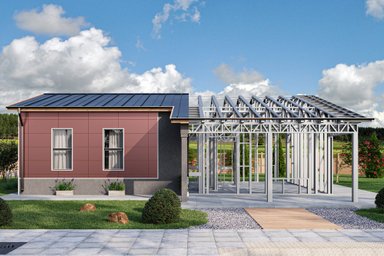Metal roofs have been steadily increasing in popularity to the point where they now make up roughly 10 percent of the residential market. Using metal for a new or replacement roof makes sense if you are making a long-term investment in your home, and can improve a home's resale value. Asphalt shingles have dominated the market in part because of sheer economics: Their up-front cost is about half that of metal. But according to the Metal Roofing Alliance, a metal roof will last three to four times as long, saving thousands of dollars in repair and replacement costs over the long run. Typically made of steel or aluminum, a metal roof is also arguably more sustainable since it is readily recyclable and can easily qualify as a "cool roof"; painted in light hues that reflect sunlight, they can substantially reduce a home's cooling costs.
Metal roofs work well with a variety of architectural styles, as this collage of designs shows:
Clockwise from top left: Southern Colonial Plan 137-107; Contemporary Craftsman Plan 454-14; Farmhouse Plan 137-252; Ranch House Plan 888-17; and Cabin Plan 452-3. To browse a collection of house plans with metal roofs, click here.
While the stereotypical metal roof is quite industrial, metal-roofing manufacturers have developed reasonable facsimiles of tile and wood shingles that work with even the most traditional of homes. You can upload a picture of your house to My New Metal Roof and mock up different roof styles. The shake roof on this gabled house is actually made of interlocking metal tiles (photo courtesy of DECRA Roofing Systems).
Meanwhile, standing-seam metal roofs, commonly used for commercial buildings, are a good fit for modern farmhouses and contemporary homes that have pitched roofs, as in Plan 935-13, above. For flat roofs, roofing membranes such as PVC are a better option because they are designed to handle pooling water. Architect Mark English, who designs contemporary homes in the San Francisco Bay Area, uses metal roofs selectively. "They're expensive, so we only use standing-seam metal for shallow-slope roofs if they can be seen from above," he says. Standing-seam metal roofs also work well with solar panels, since they will last as least as long as the panels themselves, and the metal seams create a mounting surface for the panels
(obviating the need for brackets that penetrate the roof surface, as you can see in the detail view of Plan 890-1 ).
(obviating the need for brackets that penetrate the roof surface, as you can see in the detail view of Plan 890-1 ).
One popular misconception among homeowners is that metal roofs will result in a lot of noise when it rains or storms. "I get the question all the time," says Brian Partyka, president of Louisville, Kentucky–based Drexel Metals and aboard member of the Metal Roofing Alliance. "But they're no more noisy than a traditional asphalt roof installed over a solid deck." A home's roof is typically installed over a plywood deck, which provides structure and insulating effects for any roofing material. These residential roofs are fundamentally different from the structural metal roofing of industrial warehouses, which use thicker metal that can support itself without a deck.
Metal tiles can mimic terra cotta; the latter can chip or crack over time, particularly in harsher climes; their metal equivalents, like this example, are more durable (courtesy Metal Roofing Alliance).
Since metal roofing is not as common as other types of roofing, finding a roofing installer that has specific experience with it is important. "Metal roofing tends to be more custom, so you want to find a contractor that has been certified," says Partyka. There is no industry-wide certification program, but individual manufacturers do provide training and certification for installers of their products. Your contractor should also be aware of the local building codes, which will have roofing performance requirements for wind and fire resistance and in some jurisdictions, solar reflectivity. "Both asphalt shingle and metal roofing are very mature system types—the requirements for each have been tested over time," notes Jason Wilen, director of technical services for the National Roofing Contractors Association, which offers tips for selecting a roofing professional, such as insisting on a written proposal with complete descriptions of work and specifications, starting and completion dates, and payment procedures. For more click here.
Metal roofs work well with a variety of architectural styles, as this collage of designs shows:
Clockwise from top left: Southern Colonial Plan 137-107; Contemporary Craftsman Plan 454-14; Farmhouse Plan 137-252; Ranch House Plan 888-17; and Cabin Plan 452-3. To browse a collection of house plans with metal roofs, click here.






